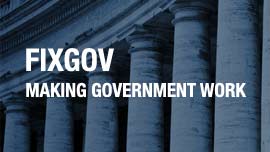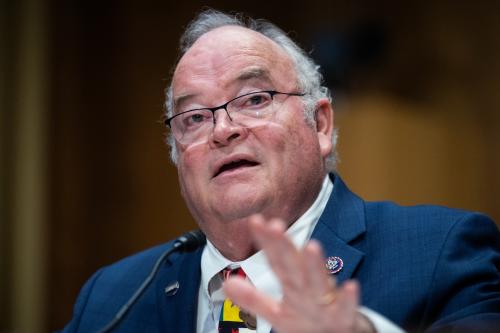Since reentering the White House in January, President Trump has enjoyed the support of narrow but unified Republican majorities in both the House and the Senate. This has enabled him to win significant legislative victories while minimizing potentially troubling congressional oversight.
If Republicans lost control of either chamber in 2026, the legislative phase of Trump’s presidency would end (unless he and the Democratic opposition pivoted toward an unlikely bipartisanship), and a stream of oversight hearings would put his administration on the defensive. For a president whose approval rests in part on his ability to move swiftly and decisively, this would be a major setback.
What are the odds that this will happen? Here’s what we know about midterms.
House elections differ structurally from Senate elections. The most obvious and consequential difference is that while every House member faces the voters every two years, only one-third of the senators do, and there is no guarantee that these senators in the aggregate will represent the actual balance between the parties.
Next year’s Senate contests illustrate this difference. Although Republicans are defending 22 seats next year compared to just 13 for Democrats, only one Republican incumbent (Susan Collins of Maine) is running in a state won by Democratic presidential candidate Kamala Harris while two Democrats (Jon Ossoff of Georgia and the winner of the nominating contest in Michigan) will be running in states Donald Trump captured on his road to victory last year. Moreover, Democrats would have to achieve a net gain of four seats to take over control of the Senate, which Republicans now hold by 53 to 47—not impossible, but a daunting challenge.
However, Republicans will have a much harder time defending their narrow majority in the House since both history and current political realities are tilting against them.
The lessons of history
With the 2026 midterm elections little more than a year away, how is the contest for control of the House of Representatives shaping up? Let’s begin with what we can learn from history.
First: the president’s party almost always loses ground in midterm House elections, as has happened in 20 of the past 22 midterm elections stretching back to 1938, and both exceptions reflected unusual circumstances. The 2002 midterms were decisively shaped by the September 11, 2001, terrorist attacks, after which public approval of President George W. Bush soared and stood at 63% on Election Day of 2002. The other exception, the 1998 midterms, took place after Republicans tried but failed to impeach President Bill Clinton and remove him from office, even though 66% of the people approved of his job performance.
Second: The president’s job approval has a strong impact on the outcome of midterm House elections. Although there are wide variations, the overall correlation is clear: The higher his job approval, the lower the losses that his party will experience. As Election Day nears, the correlation becomes tighter.
Even when the midterms are more than a year away, the president’s job approval has non-trivial predictive power. Still, inferences from such early data must be drawn with caution and stated with appropriate caveats. For example, the 53% job approval Barack Obama enjoyed in the fall of 2009 had fallen to 45% a year later, setting the stage for the large losses Democrats suffered in the 2010 midterms. This said, during the past three decades, every time the president’s net job approval (approval minus disapproval) was negative a year before a midterm election, the president’s party lost ground in the House.
Third: The more House seats the president’s party holds, the larger its losses in the midterms tend to be. The explanation for this link is straightforward: To the extent that a popular presidential candidate has “coattails,” helping members of his party win seats they would have lost otherwise, his absence on the ballot in the next election will have a significant effect. Historical patterns illustrate this dynamic. FDR’s landslide victory in 1936 was followed by a loss of 72 Democratic House seats in the 1938 election. Following LBJ’s massive defeat of Barry Goldwater in 1964, the Democrats lost 47 seats in the 1966 election. And after Barack Obama’s victory over John McCain in 2008—with the highest margin of victory in two decades that helped propel House Democrats to their largest majority since 1992—they lost 63 seats, and their majority, two years later.
Fourth: In the past four elections, a strong correlation has developed between the share of the national House vote each party receives and the share of House seats it wins. There is an even more striking correlation: Comparing the six midterm elections since 2000 with the preceding presidential contests, the changes in the number of House seats going to each party after the midterms correspond very closely to the swings between the presidential and midterm elections in the vote shares received by the two parties.
A hypothetical example will clarify the meaning of “swing.” Suppose that in a presidential year, Party A gets 52% of the national House vote and Party B gets 48%. In the midterm two years later, Party A loses four points of its national vote share and ends up with 48% while Party B gains four points, to 52%. The swing would be the sum of these changes—eight points.
Here are the results since 2000:
As Figure 1 shows, the vote swings in the six post-2000 midterms vary from a low of 4.3 points in 2002 to a high of 17.4 points in 2010, corresponding to a low of eight seats gained in 2002 to a high of 63 seats in 2010. The relationship between swings and seat gains is nearly linear.
What does this history tell us about the 2026 midterm elections?
As we have seen, the president’s party almost always loses ground in the midterm election following his victory, and the unusual circumstances that fueled the two exceptions since the 1930s do not seem to prevail today. After the 2024 election, moreover, Republicans held only 220 seats, just two more than the minimum needed for a majority. Barring unforeseeable game-changing events during the next 14 months, the probability that Republicans will lose control of the House is very high.
This said, the national fight kicked off by the five-seat gain Texas Republicans scored by redrawing the lines of their congressional districts could end up making Democrats’ job slightly more difficult, even if California Democrats are able to counterbalance Texas with their own redistricting plan. But when the dust settles, the number of seats Democrats will need to take over the House will remain in single digits, a modest number by historical standards.
If history is any guide, President Trump’s personal relationship with his supporters may work to the Democrats’ advantage, as it did in the 2018 midterm election after Trump’s upset victory over Hillary Clinton in 2016. In 2018, total support for House Republican candidates fell by more than 11.9 million votes (19%) from its 2016 level. Many Trump supporters didn’t turn out to vote when his name didn’t appear on the ballot. By contrast, total votes for House Democratic candidates in 2018 fell by only 845,000 (less than 2%) from their level two years earlier. The result: a 41-seat gain for House Democrats, enabling them to regain control of the House with a 36-seat majority.
There is no modern precedent for such a small gap between a party’s congressional showing in presidential and midterm elections, suggesting that Trump’s intense personal support was matched by the antipathy he aroused among Democrats. Nor is there evidence that the intensity of Democratic opposition to Trump has diminished. The remaining unknown is the extent to which Republicans can narrow the gap, so evident in 2018, between support for Trump and for their House candidates.
If Republicans are to have a serious chance of retaining control of the House, President Trump will have to improve his job approval significantly. A widely used unweighted average of recent surveys places his approval at 45.8% and disapproval at 50.9%, a net of -5.1. An average that weights polls for recency, quality, and other factors finds 44.3% approval and 52.2% disapproval, a net of -7.9. The president’s standing is especially low among groups that shifted toward him in last year’s presidential election—just 28% approval among Hispanics and Independents and 29% among young adults ages 18 to 29.
As we have seen, there is no modern precedent for the president’s party to avoid losses in the House unless the president’s job approval is well above 50%. By this measure, Trump has a long way to go.
The current reading of the two parties’ overall support for their House candidates (the “generic ballot”) points to the same conclusion. Right now, Democrats enjoy an advantage of 3.9 points, compared to their 2.6 point loss in the 2024 House elections—a swing of 6.5 points. If the election were held tomorrow, our swing/seat-change chart predicts a Republican loss of about 12 seats, while our analysis of recent patterns—showing House seats have been distributed in proportion to the national House vote—predicts a Democratic total of 226, a gain of 11 seats.
A granular seat-by-seat analysis places potential Republican losses in the same ballpark. As analysts have noted, Republicans have more safe seats than Democrats. For example, the respected Cook Political Report assesses 191 Republican seats as unlikely to change hands, compared to 175 for Democrats. This means that 29 Republican seats are in some level of jeopardy, compared to 40 for Democrats.
Brookings research points in the same direction. We find that of the 37 seats won by less than five points in 2025, Democrats hold 22 and Republicans, 15. Of the 32 seats won by five to 9.99 points, Democrats hold 24, Republicans, just eight. Even so, a swing of 6.5 points toward the Democrats in the overall House vote would produce a Democratic seat gain of about 19 and a majority of 33 (234-201). Even if Republicans achieve a net gain of five seats from the national redistricting war now underway, a 14-seat gain by Democrats would give them a House majority of 23 seats (229-206).
As a group, the 19 most vulnerable Republican districts present an interesting profile. Only one is predominantly rural, and only one is in the South; the majority are from the Northeast, Mid-Atlantic, and Midwest. Most are near or above the national averages for college education and household income. These are not the kinds of districts that seem ripe for a national message focused on divisive cultural issues. A nationalized Republican campaign featuring the red meat appeals to which the MAGA base responds could backfire badly in the swing districts the party must carry to retain its House majority.
What could change between now and November 2026?
This analysis has focused on what would happen if the midterm elections were held tomorrow. But of course they will not be. If President Trump’s job approval were to rise significantly in the next 14 months, he could lead Republicans to a history-defying victory in the House.
A president’s job approval reflects the public’s assessment along two dimensions—personal attributes and conduct, and his handling of key issues. For better and worse, the electorate’s evaluation of Donald Trump along the first dimension is deeply entrenched. On the plus side, he is regarded as a strong, intelligent leader who stands up for what he believes in, and nearly half of all voters regard him as an able negotiator. On the minus side, he is seen as dishonest, uncaring, and a poor role model. Because Trump has been at the center of public attention for most of the past decade, it is hard to see what would shift these judgments.
Change along the second dimension of assessment—performance on the issues— is easier to imagine. Right now, the public gives President Trump low marks on every issue except border security, and even there, we see some indications that his support is weakening. On the issues the public regards as most important—inflation, jobs and the economy, and health care—Trump is struggling. In an average of recent surveys, only 38% of Americans approve of his handling of inflation, while 59% disapprove. While he gets somewhat better grades on jobs and the economy, only 26% rate the state of the economy as good or excellent, compared to 71% who give it a grade of fair or poor. Only 24% think the economy is getting better, while 53% view it as getting worse, and only 29% believe that they and their families will be better off a year from now than they are today.1 And only 36% approve of the centerpiece of Trump’s economic policy—his handling of trade—while 56% disapprove. And on health care, the unpopular Medicaid cuts in the “Big Beautiful Bill” contributed to a dismal public evaluation of his performance.
Events between now and November 2026 could change these views. Economists could be wrong about the inflationary effects of tariffs and mass deportations. The rising inventory of unsold houses could halt the relentless increase in home prices, and interest rate cuts by the Federal Reserve Board could reduce the cost of home mortgages. The recent slowdown in the labor market could turn out to be temporary. And because most of the Medicaid cuts do not begin to take effect until after the midterm elections, and even more are delayed until after the 2028 presidential contest, voters could decide that the issue had been overhyped by Trump’s adversaries.
Finally, a game-changing issue could emerge unexpectedly. This happened during the runup to the 2022 midterm elections, when the Supreme Court decision overruling Roe v. Wade galvanized Democrats, reducing what otherwise could have been a Republican surge to a modest swing of 5.5 points in the national House vote and a loss of just nine Democratic House seats (enough to shift control of the House to the Republicans, however).2
Still, the odds that public sentiment will shift enough to extend Republicans’ control of the House seems low, an assessment reinforced by the parties’ changing demographic bases. As working-class Americans have shifted toward Republicans, Democrats have received a rising share of Americans with bachelor’s and other professional degrees. These highly educated voters tend to vote more regularly than others, especially in off-year and midterm elections, while Republicans may find it difficult to mobilize the less-attached voters whom Trump brought off the sidelines when he is not on the ballot, even if he campaigns vigorously for his party’s candidates next year. If so, Republicans could experience a rerun of 2018, when a massive mobilization of anti-Trump Democrats combined with a less motivated Republican base to produce a large shift toward Democrats, and a change of party control in the House of Representatives.
This said, Democrats should bear in mind another key lesson of history: The outcome of midterm elections does not predict the winner of the subsequent presidential election. A gain of 26 House seats in the 1982 midterms fueled Democratic hopes but did not save Walter Mondale from a landslide defeat at the hands of Ronald Reagan in 1984. Conversely, a 54-seat Democratic loss in 1994 seemed to leave Bill Clinton’s presidency on life support, but he went on to beat Republican nominee Bob Dole by eight percentage points just two years later. An even larger Democratic loss of 63 seats in 2010 seemed to doom Barack Obama’s reelection prospects, but he came back to defeat Mitt Romney by almost five million votes in 2012.
Not only is the electorate in presidential years larger than in midterms, with a higher share of less motivated voters, but also the dominant issues can differ. In 2022, anger at the Supreme Court decision overturning Roe v. Wade helped Democrats mute the effects of inflation and keep their seat loss in the House to single digits, despite predictions of a “red wave.” Two years later, Kamala Harris’ emphasis on abortion rights as an issue of “freedom” did not raise it to the top tier of issues that dominated the election and led to her defeat.
The 2026 midterms will have important consequences for the remaining two years of Donald Trump’s presidency. But whatever happens next November, the 2028 presidential election will begin in earnest the very next day, and it will be a whole new ballgame.
-
Footnotes
- Complicating this analysis, some political science research suggests that in recent midterm elections, the impact of economic conditions has declined. One possible explanation: As political polarization has intensified, voters are more likely to view economic conditions through partisan lenses. For a discussion, see https://surface.syr.edu/cgi/viewcontent.cgi?article=2740&context=honors_capstone.
- For a detailed assessment of the unusual 2022 midterms, see The US mid-term elections of 2022: what influenced the outcomes? – Economics Observatory.
The Brookings Institution is committed to quality, independence, and impact.
We are supported by a diverse array of funders. In line with our values and policies, each Brookings publication represents the sole views of its author(s).








Commentary
What history tells us about the 2026 midterm elections
August 28, 2025